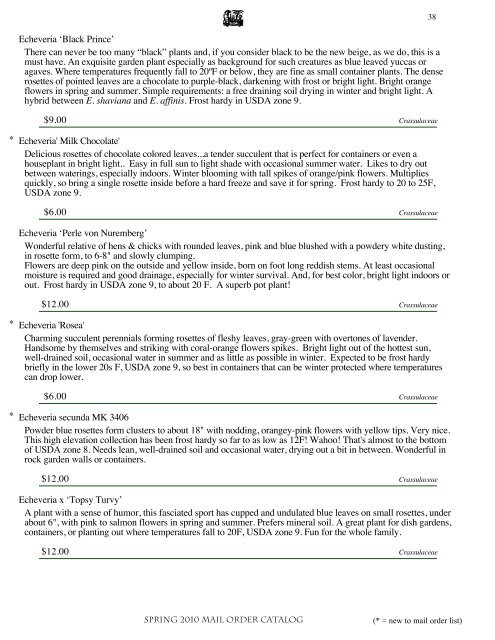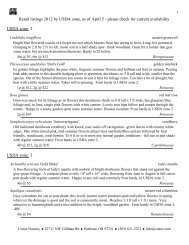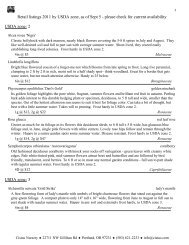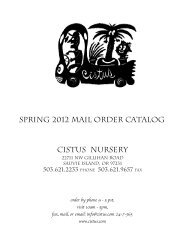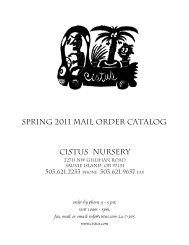Mail Order Catalog Fall 2010 - Cistus Nursery
Mail Order Catalog Fall 2010 - Cistus Nursery
Mail Order Catalog Fall 2010 - Cistus Nursery
You also want an ePaper? Increase the reach of your titles
YUMPU automatically turns print PDFs into web optimized ePapers that Google loves.
Echeveria ‘Black Prince’<br />
There can never be too many “black” plants and, if you consider black to be the new beige, as we do, this is a<br />
must have. An exquisite garden plant especially as background for such creatures as blue leaved yuccas or<br />
agaves. Where temperatures frequently fall to 20ºF or below, they are fine as small container plants. The dense<br />
rosettes of pointed leaves are a chocolate to purple-black, darkening with frost or bright light. Bright orange<br />
flowers in spring and summer. Simple requirements: a free draining soil drying in winter and bright light. A<br />
hybrid between E. shaviana and E. affinis. Frost hardy in USDA zone 9.<br />
$9.00<br />
$6.00<br />
38<br />
Crassulaceae<br />
* Echeveria' Milk Chocolate'<br />
Delicious rosettes of chocolate colored leaves...a tender succulent that is perfect for containers or even a<br />
houseplant in bright light.. Easy in full sun to light shade with occasional summer water. Likes to dry out<br />
between waterings, especially indoors. Winter blooming with tall spikes of orange/pink flowers. Multiplies<br />
quickly, so bring a single rosette inside before a hard freeze and save it for spring. Frost hardy to 20 to 25F,<br />
USDA zone 9.<br />
Crassulaceae<br />
Echeveria ‘Perle von Nuremberg’<br />
Wonderful relative of hens & chicks with rounded leaves, pink and blue blushed with a powdery white dusting,<br />
in rosette form, to 6-8" and slowly clumping.<br />
Flowers are deep pink on the outside and yellow inside, born on foot long reddish stems. At least occasional<br />
moisture is required and good drainage, especially for winter survival. And, for best color, bright light indoors or<br />
out. Frost hardy in USDA zone 9, to about 20 F. A superb pot plant!<br />
$12.00<br />
$6.00<br />
Crassulaceae<br />
* Echeveria 'Rosea'<br />
Charming succulent perennials forming rosettes of fleshy leaves, gray-green with overtones of lavender.<br />
Handsome by themselves and striking with coral-orange flowers spikes. Bright light out of the hottest sun,<br />
well-drained soil, occasional water in summer and as little as possible in winter. Expected to be frost hardy<br />
briefly in the lower 20s F, USDA zone 9, so best in containers that can be winter protected where temperatures<br />
can drop lower.<br />
$12.00<br />
Crassulaceae<br />
* Echeveria secunda MK 3406<br />
Powder blue rosettes form clusters to about 18" with nodding, orangey-pink flowers with yellow tips. Very nice.<br />
This high elevation collection has been frost hardy so far to as low as 12F! Wahoo! That's almost to the bottom<br />
of USDA zone 8. Needs lean, well-drained soil and occasional water, drying out a bit in between. Wonderful in<br />
rock garden walls or containers.<br />
Crassulaceae<br />
Echeveria x ‘Topsy Turvy’<br />
A plant with a sense of humor, this fasciated sport has cupped and undulated blue leaves on small rosettes, under<br />
about 6", with pink to salmon flowers in spring and summer. Prefers mineral soil. A great plant for dish gardens,<br />
containers, or planting out where temperatures fall to 20F, USDA zone 9. Fun for the whole family.<br />
$12.00<br />
Crassulaceae<br />
Spring <strong>2010</strong> <strong>Mail</strong> <strong>Order</strong> <strong>Catalog</strong> (* = new to mail order list)


